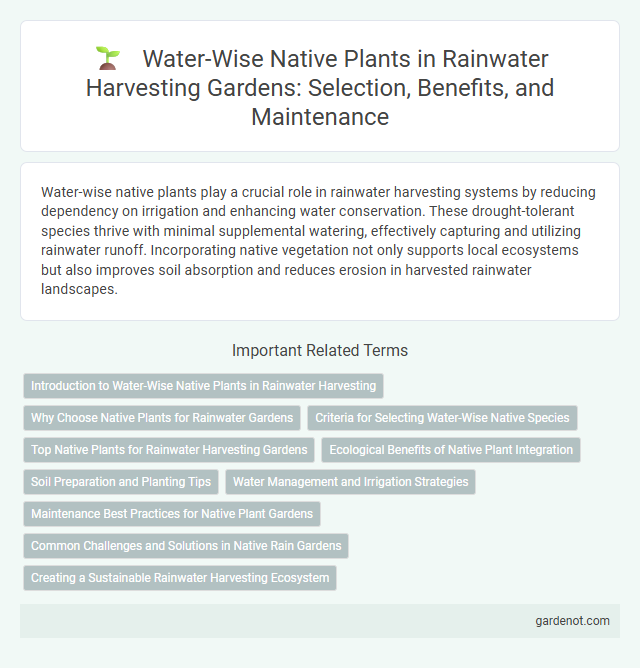Water-wise native plants play a crucial role in rainwater harvesting systems by reducing dependency on irrigation and enhancing water conservation. These drought-tolerant species thrive with minimal supplemental watering, effectively capturing and utilizing rainwater runoff. Incorporating native vegetation not only supports local ecosystems but also improves soil absorption and reduces erosion in harvested rainwater landscapes.
Introduction to Water-Wise Native Plants in Rainwater Harvesting
Water-wise native plants play a critical role in rainwater harvesting by efficiently absorbing and utilizing accumulated rainfall while reducing irrigation needs. These plants, adapted to local climate and soil conditions, enhance groundwater recharge and decrease surface runoff, promoting sustainable water management. Integrating water-wise native species in rain gardens or swales maximizes rainwater retention and supports local biodiversity.
Why Choose Native Plants for Rainwater Gardens
Native plants in rainwater gardens enhance water absorption and reduce runoff due to their deep root systems adapted to local soil and climate conditions. These plants improve soil structure and increase biodiversity, supporting pollinators and other wildlife while minimizing maintenance and irrigation needs. Choosing native species ensures sustainable rainwater management, promoting ecosystem resilience and water conservation.
Criteria for Selecting Water-Wise Native Species
Selecting water-wise native species for rainwater harvesting projects requires evaluating drought tolerance, root system depth, and adaptability to local soil types. Prioritize plants with high transpiration efficiency and native status to ensure minimal supplemental irrigation and enhanced water conservation. Consider species with proven resistance to pests and diseases to promote sustainable, low-maintenance landscapes.
Top Native Plants for Rainwater Harvesting Gardens
Top native plants for rainwater harvesting gardens include species like purple coneflower (Echinacea purpurea), switchgrass (Panicum virgatum), and black-eyed Susan (Rudbeckia hirta), which efficiently absorb and filter rainwater. These water-wise natives enhance soil infiltration and reduce runoff, promoting sustainable landscaping practices. Selecting regionally adapted native plants maximizes rainwater retention and supports local ecosystems by providing habitat and improving biodiversity.
Ecological Benefits of Native Plant Integration
Water-wise native plants enhance rainwater harvesting systems by improving soil infiltration and reducing runoff, which supports groundwater recharge. These plants require minimal irrigation and fertilizer, decreasing water usage and limiting chemical runoff that can harm ecosystems. Their deep root systems stabilize soil, prevent erosion, and create habitats for local wildlife, promoting biodiversity and ecological balance.
Soil Preparation and Planting Tips
Selecting water-wise native plants enhances rainwater harvesting efficiency by thriving in local climate conditions with minimal irrigation. Proper soil preparation involves deep tilling and incorporating organic compost to improve water retention and root penetration. Planting native species during early rainy seasons ensures optimal establishment and reduces the need for supplemental watering.
Water Management and Irrigation Strategies
Water-wise native plants significantly reduce irrigation needs by utilizing efficient root systems adapted to local rainfall patterns, optimizing water retention in soil. Implementing drip irrigation and mulching alongside these species enhances water management by minimizing evaporation and targeting moisture directly to plant roots. Integrating these strategies supports sustainable rainwater harvesting by conserving groundwater resources and reducing runoff.
Maintenance Best Practices for Native Plant Gardens
Water-wise native plant gardens require regular maintenance to optimize rainwater harvesting by ensuring soil health and plant vitality. Key practices include mulching to retain moisture, monitoring for pests to prevent damage, and periodic pruning to promote growth and water efficiency. Proper irrigation scheduling aligned with native plants' drought tolerance minimizes water waste and supports sustainable garden resilience.
Common Challenges and Solutions in Native Rain Gardens
Common challenges in native rain gardens include soil compaction, poor drainage, and invasive species outcompeting native plants. Solutions involve selecting appropriate drought-tolerant native species, amending soil with organic matter to improve infiltration, and regularly monitoring for invasive plants to maintain ecosystem balance. Proper design and maintenance ensure efficient water capture and support local biodiversity.
Creating a Sustainable Rainwater Harvesting Ecosystem
Water-wise native plants significantly enhance the sustainability of rainwater harvesting ecosystems by efficiently absorbing and filtering runoff, reducing soil erosion, and promoting groundwater recharge. Selecting drought-tolerant and deep-rooted native species minimizes irrigation needs and supports local biodiversity, resulting in a resilient landscape that conserves water. Integrating these plants into rain gardens or bioswales maximizes rainwater retention and improves the overall health of the watershed.
Water-wise native Infographic

 gardenot.com
gardenot.com